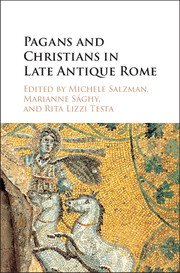 Pagans and Christians in Late Antique Rome
Pagans and Christians in Late Antique Rome Book contents
- Frontmatter
- Contents
- List of Illustrations
- Biographies of Authors
- Acknowledgments
- Introduction
- Part I SENATORIAL POLITICS AND RELIGIOUS CONFLICT
- Part II The Construction of New Religious Identities
- Part III Pagans and Christians: Coexistence and Competition
- Section A Pagans and Religious Practices in Christian Rome
- Section B Death and the Afterlife
- Section C Reading Religious Iconography as Evidence for Pagan–Christian Relations
- 16 Rome and Imagery in Late Antiquity: Perception and Use of Statues
- 17 What to Do with Sacra Antiqua? A Reinterpretation of the Sculptures from S. Martino ai Monti in Rome
- 18 Myth and Salvation in the Fourth Century: Representations of Hercules in Christian Contexts
- Concluding Remarks: Vrbs Roma between Pagans and Christians
- Index
18 - Myth and Salvation in the Fourth Century: Representations of Hercules in Christian Contexts
from Section C - Reading Religious Iconography as Evidence for Pagan–Christian Relations
Published online by Cambridge University Press: 05 November 2015
- Frontmatter
- Contents
- List of Illustrations
- Biographies of Authors
- Acknowledgments
- Introduction
- Part I SENATORIAL POLITICS AND RELIGIOUS CONFLICT
- Part II The Construction of New Religious Identities
- Part III Pagans and Christians: Coexistence and Competition
- Section A Pagans and Religious Practices in Christian Rome
- Section B Death and the Afterlife
- Section C Reading Religious Iconography as Evidence for Pagan–Christian Relations
- 16 Rome and Imagery in Late Antiquity: Perception and Use of Statues
- 17 What to Do with Sacra Antiqua? A Reinterpretation of the Sculptures from S. Martino ai Monti in Rome
- 18 Myth and Salvation in the Fourth Century: Representations of Hercules in Christian Contexts
- Concluding Remarks: Vrbs Roma between Pagans and Christians
- Index
Summary
One of the most powerful and most beloved heroes of antiquity, Hercules, figures positively not only in pagan myth, but in its iconography where he was seen as civilizing the earth by saving humans from various monsters and evil forces. He was also positively represented in Christian contexts. As I will argue in this chapter, Hercules, man and god with superhuman abilities, was a heroic figure for late antique Christians too. The Christian predilection for Hercules was not an unproblematic interpretatio Christiana, but a complex conjunction of mythical and Christian models of virtue that offered a polyvalent religious experience for late antique Romans.
Hercules images abound in late antiquity. Fourth-century Constantinople boasted several statues of Hercules, and ivory reliefs, silverware, gold glass, contorniates, terra sigillata vessels, bronze plates, and casket mounts were equally decorated with the exploits of the demigod. Of these representations, two fourth-century Christian iconographical programs stand out that combine the myth of Hercules with biblical scenes: the frescoes of the cubiculum N of the Via Latina catacomb in Rome and the reliefs of a casket mount from Ulcisia in Pannonia (now Szentendre, Hungary). Common to these representations that differ so much in artistic ambition, media, and size, is the drive to “think with” Hercules when visualizing the Christian history of salvation.
Hercules in the Catacomb
The Hercules cycle in cubiculum N of the Via Latina catacomb (Via Dino Compagni) remains the most contested piece of mythological iconography in art history. Cubicula D–O were painted by a workshop of three painters in the last decades of the fourth century, heavily inspired by the former workshop of cubicula A–C active during the Constantinian period. Possibly commissioned by a married couple, cubiculum N has two arcosolia painted with scenes from the Alcestis myth (Figure 18.1) representing two labors of Hercules: killing the Hydra of Lerna and stealing the apples of the Hesperides. The lunette of the left-hand arcosolium shows the dying Admetus, King of Thessaly, surrounded by his family and Hercules and Minerva, the personification of Virtue. The next image shows Hercules, club in hand, killing an enemy, presumably Alcyoneus, Cacus, Antaeus, or Death itself. In the lunette of the right-hand arcosolium, Hercules leads Alcestis from the underworld to the doorstep of the house of Admetus. Adorned with halo, club, and lion skin, Hercules holds Cerberus on a leash.
- Type
- Chapter
- Information
- Pagans and Christians in Late Antique RomeConflict, Competition, and Coexistence in the Fourth Century, pp. 379 - 400Publisher: Cambridge University PressPrint publication year: 2015


